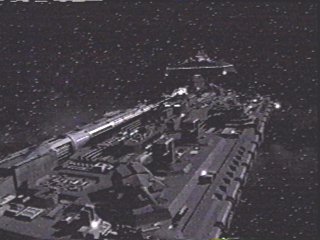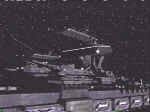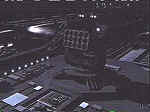The following material is an adaptation of the starship design from MACROSS
PLUS and MACROSS-7, a sequel to the original Japanese MACROSS TV series (which
became Robotech here in the U.S.). Please feel free to use, copy, and distribute
it as you see fit. Comments and suggestions are welcome.
MOUNT MITCHELL-CLASS
AMPHIBIOUS COMMAND CARRIER
- RPG Stats by Kamikazi (
[email protected])
- Layout Style Adapted from DAVE DEITRICH(
[email protected])
- Background info provided by COMBAT FLEETS OF
THE WORLD 86/87 and
- THE USMC 13th MEU HOMEPAGE
-

BACKGROUND
Since Space War I, in nearly every crisis in which
the UN Spacy has deployed projection forces, the first military units in
position to move ashore with sufficient sustainability for prolonged operations
have been from one of the UN's Fleet Marine Forces. These forces have been
organized into Marine Air Ground Task Forces (MAGTF) - a combination of air,
ground and support assets. MAGTFs are established for specific missions,
or in anticipation of a wide range of possible missions. Combining air, ground,
and logistic assets maximizes the combat power of each of the war-fighting
elements. MAGTFs have long provided the UN Spacy with a broad spectrum of
response options when U.N. interests have been threatened and in noncombat
situations which require instant response to crisis. Selective, timely and
credible commitment of air-ground units have, on many occasions, helped bring
stability to a region and sent signals worldwide to aggressors that the UN
Spacy is not only willing to defend its interests, but able to do so with
a significantly powerful force on extremely short notice.
The Amphibious Command Ship (LCC) is a purpose built platform,
designed to direct and manage every phase of command and control
operations. Here for the first time is a space platform built from the keel
up to accomplish the mission of Command and Control coordination.
Mount Mitchell represents the accumulated knowledge of five
decades of the Spacy's experience in meeting difficult challenges
of Control and Coordination.
Mount Mitchell utilizes its "main battery" of computers, communications
equipment and other electronic facilities to fulfill her mission
as flagship for the United Nations Amphibious Fleet. These systems are also
instrumental in its function as a command ship for the Amphibious
Task Force and Landing Force Commanders during all phases of fleetwide
operations.
The Mount Mitchell is the most capable command ship ever built, with
an extremely sophisticated Command and Control system. The Joint Maritime
Command Information System (JMCIS) consists of numerous powerful computers
distributed throughout the ship from which information and data from worldwide
sources are entered into a central database. This single integrated database
concentrates the available information into a complete tactical picture of
air, space, surface and subsurface contacts, enabling the Fleet Commander
to quickly assess and concentrate on any situation which might arise. This
ability to access information from military and civilian sources throughout
the galaxy gives Mount Mitchell a command and control capability unparalleled
in Spacy history.

RPG STATS
- Government: New United Nations Government
- Ship Type: Amphibious Command Ship (LCC)
- Class: Mount Mitchell-Class Amphibious
Command Ship
- Manufacturer: ORTEC Company/Three Star Heavy
Industries/UN Spacy
- Length: 4,950 ft (1,500 m)
- Width: 234.77m (maximum cross section)
- Height: 64.6m
- Displacement, tons: 2,500,000
tons (empty) / 3,100,000 tons (standard)
- Crew:
- Officers: 104
- Crew: 850
- Marines: 1040
- Command Personnel: 565
- Pilots: 80
- Other Personnel: 395
- Total Compliment: 1994
- Ships in Class:
-
- LCC-28
UNS Mount Mitchell (launched 2050)
- LCC-29 UNS Mount
McKinley
(launched 2050)
MDC BY LOCATION:
(1) Main Body 40,000
(2) Command Tower 8,000
(2) Communication Array (behind Command Tower) 800
(3) Foredeck 12,000
(3) Flight decks (2) 8,000 each
(4) Main engines (2) 8,000 each
(4) Secondary Engines (2) 2,500 each
(4) Small Guidance thrusters (36) 200 each
Medium Range Missile Launchers (6) 200 each
Retractable Laser Turrets (12) 300 each
Phalnax CIWS Turrets (12) 250 each
Small Airlocks/Access Hatches (100) 250 each
Large Airlocks (20) 500 each
Outer Hull (per 40ft area) 120
Interior walls (per 20ft) 20
(5) Pin Point Barriers (4) 5,000 each
NOTES:
- Depleting the
MDC of the main body will put the Command Ship out of commission. All internal
systems will shut down, including life support and internal gravity.
The ship itself will be an unsalvageable floating wreck.
- Destroying
the command tower will instantly kill the command staff and deprive
the ship of all forms of long range communications, radar and targeting.
The range and targeting capabilities of the secondary systems are
equal to that of a VF-11 Thunderbolt.
The ship can still operate, but is at -3 on initiative, -3
to strike, and number of attacks per melee of the weapon systems
are reduced by half. Destroying the main sensory array behind the
command tower will have the same effect, but the command staff will
not be killed instantly.
- Destroying
the foredeck or the flight decks will greatly impair the ship's ability
to deploy and recover aircraft. Under normal operations the carrier
can launch or recover up to 12 VFs per turn. If the foredeck is
destroyed this number drops to 6, and each flight deck destroyed
reduces this number by 3. If both the foredeck and the flight decks
are destroyed the carrier can only launch or recover one aircraft
every other turn.
- Depleting the
MDC of the main engines will force the ship to rely on its secondary
engines. Depleting the MDC of the main engines AND secondary engines
will leave the ship adrift in space. If in an atmosphere, the ship
will crash (destruction of the main engines will render the
antigravity system useless due to loss of power).
- The Pinpoint
Barriers regenerate at a rate of 1,250 MD per second (2,500 MD per
melee round). If destroyed, a barrier will completely regenerate
within four seconds (2 melee rounds). See the Pinpoint
Barrier System entry for details.
SPEEDS:
- Speed(sublight):
0.20 speed of light (32,000 miles per second)
- Speed(Auxiliary
Drives): Mach 3
- Space
Fold: Range Unlimited (1 light year every 6 minutes)
- Planet
bound:
- Can only
land in water if necessary and is not designed to maneuver in an
atmosphere.
-
(Note: Landing on land will completely destroy the main communications
array.)
-
Maximum Range: Unlimited (estimated 30 year life span)
WEAPON SYSTEMS:
-
 MEDIUM MISSILE LAUNCHERS (6): The command ships are armed with six medium missile
launchers which are primarily intended for anti-aircraft defense.
Each launcher contains 15 missile tubes allowing volleys of up to 15 missiles to be fired at a single target per launcher. Once
depleted, the missile launchers are reloaded by an automated loading
system that takes 15 seconds (one melee round) to reload all 15 missiles.
Armor-piercing smart missiles are usually used to avoid chances of
friendly fighters being shot down by the missiles.
MEDIUM MISSILE LAUNCHERS (6): The command ships are armed with six medium missile
launchers which are primarily intended for anti-aircraft defense.
Each launcher contains 15 missile tubes allowing volleys of up to 15 missiles to be fired at a single target per launcher. Once
depleted, the missile launchers are reloaded by an automated loading
system that takes 15 seconds (one melee round) to reload all 15 missiles.
Armor-piercing smart missiles are usually used to avoid chances of
friendly fighters being shot down by the missiles.
-
PRIMARY PURPOSE: Anti-Aircraft
-
SECONDARY PURPOSE: Anti-Warship
-
MISSILE TYPES: Any type of UN Spacy Medium
Range Missile can be used. Smart missiles are commonly
used to avoid hitting friendly aircraft.
-
RANGE: Varies, typically 60 miles (80.4 km).
-
SPEED: Varies, typically 1600mph (2571kmph).
-
DAMAGE: Varies, typically 2D4x10 M.D.
-
BLAST RADIUS: Varies, typically 15 feet.
-
RATE OF FIRE: One at a time or volleys of 3, 5, or 15 missiles per launcher.
-
PAYLOAD: Each launcher holds 15 missiles. Once the missiles
are expended the launcher is reloaded within 1 round via
an automated system. The reload system holds 45 missiles
per launcher.
-
RETRACTABLE LASER TURRETS (12): As a final line of defense the
command ship is armed with 12 automated laser turrets that retract
into the ship's hull when not in use. These short-range lasers are
intended primarily for anti-aircraft and anti-missile defense, but
can do moderate damage against smaller enemy spacecraft if they
get too close. The lasers are located at key points along
the spacecraft's hull. At most 4 lasers can be directed against a
single target at any time.
-
PRIMARY PURPOSE: Anti-Missile
-
SECONDARY PURPOSE: Anti-Aircraft
-
RANGE: 30 miles (48.2 km) in an atmosphere. Double in
space.
-
DAMAGE: 1D6x20 M.D. per shot
-
RATE OF FIRE: Equal to the controller's number of hand-to-hand
attacks. If set on automatic each laser turret can fire up
to 4 shots per round.
-
PAYLOAD: Unlimited.
-
NOTE: The lasers can be set on automatic during combat,
during which time they have a +3 to strike due to their advanced
tracking systems. The lasers tracking systems will target
incoming missiles first and attacking mecha/aircraft
second.
- PHALANX"
GATLING
TURRETS
(12):
The
55mm
"Phalanx"
tri-tube
gatling
cannon
is
directly
derived
from
the
one
used
by the
VF-1
Valkyrie
fighters.
The
command
carriers
have
12
turrets
mounted
at
strategic
places
along
the
hull.
- PRIMARY
PURPOSE:
Defense
- SECONDARY
PURPOSE:
Anti-Mecha
- RANGE:
8000
ft
(2400
m)
- DAMAGE:
1D4x10
M.D.
per
blast
- RATE
OF
FIRE:
Each
turret
can
fire
three
times
per
melee
(15
seconds),
and
can
be
directed
at
different
targets.
- PAYLOAD:
Unlimited
- BONUS:
+3
when
firing
on
missiles
-
PINPOINT BARRIER DEFENSE SYSTEM: Originally developed by researchers
onboard the SDF-01 Macross during Space War One, the Pinpoint Barrier
System is a standard defense system on board all UN Spacy starships,
including the Mount Mitchell command ships. The system
generates four small disc-shaped force fields that can be positioned
anywhere along the ship to deflect missiles, energy beams or projectiles.
Each pinpoint barrier is about 200 ft (61 m) in length and can absorb
up to 5,000 MD in damage, which then regenerates within four seconds
(2 melee rounds). The barriers can also be layered on top
of each other to generate a field which provides 20,000 MDC and
can even deflect heavy particle beams (usually).
The four barriers are controlled by operators in the command
tower of the carrier. These operators are instructed to defend
(1) the command tower, bridge, and sensor array, (2) main engines,
(3) hangar bays, and (4) weapon systems, in that order. The operators
primarily concentrate on defending the ship against larger
spacecraft and leave defense against mecha attacking the carrier
to the VF pilots.
-
PRIMARY PURPOSE: Defense (the pinpoint barrier system
cannot be used as a weapon)
-
RANGE: Up to 300 feet (91.5 m) from the surface of the
vessel.
-
DAMAGE CAPACITY: Can sustain up to 5,000 MD per round.
Regenerates at a rate of 2,500 MD per melee round.
-
RADIUS: 200 ft (61 m)
-
DEFENSIVE MOVEMENT: Can move from one end of the carrier
to the other in less than a single round. Trained operators
can attempt to block attacks up to 8 times per melee (counts
as a parry) and are at +7 to block. Untrained
characters can parry up to their number of hand-to-hand
attacks with their normal parry bonuses only.
-
PAYLOAD: Nearly inexhaustible. Will work as long as system
is functional (see below) and engines are intact. If main
engines are destroyed, the barrier will loose power and not
function.
-
NOTE: If all four barriers are grouped in a single spot
they can deflect a heavy particle beam attack, such as the
one generated by the Macross Cannon, Zentraedi/Varuta command
warships, and some Protodeviln. However, the beam
will completely destroy all four barriers and put
incredible strain on the pinpoint barrier system, to the
point where it may short out. After deflecting an energy
beam, roll percentile dice on the table below to determine
additional effects/damage.
-
01-15: Lucked out, system will be operational
in 1D6 hours.
-
16-30: Minor damage, system will require 4D6
hours to repair.
-
31-45: Major damage, system will require 2D6x10
hours to repair (yes, DAYS of work).
-
46-60: Completely destroyed! System can be rebuilt,
but will require new parts and 2D6 DAYS of work to
replace.
-
61-75: Major damage, system will require 2D6x10
hours to repair.
-
76-90: Minor damage, system will require 4D6
hours to repair.
-
91-95: Lucked out, system will be operational
in 1D6 hours.
-
96-00: It's a miracle! Trivial damage only, system
will be operational again in only 4D6 melee rounds!
-
MOBILE WEAPONS SYSTEMS (2050): The Mount Mitchell class
command ships carry no craft of their own. Instead, they rely on a small compliment of Marine craft on board.
-
VF-24M Raptor II: 15 (1 squadron) on active status. Used primarily
for close support.
-
VE-11 "Cyclops" Thunderbolt: 4 (1/4 squadron) Used for Electronic
Warfare and AWACS
-
MS-42 Sky Mule Assault Shuttles: 8 (1/2 squadron) Used for evacuation
and
transport
planetside
SYSTEMS OF NOTE:
-
HOSPITAL FACILITIES: The Mount Mitchell-class vessels have
a very complete 300 bed hospital facility for treating the wounded of any
conflict. Mortuary facilities are also equipped in the contingency of heavy
casualties.
-
ANTIGRAVITY PROPULSION SYSTEM: The Mount Mitchell-class
vessels are equipped with an anti-gravity propulsion system used
for planetary landings and liftoffs. The system is good for vertical
ascent/descent only and can lift the ship at speeds of up to 1,320
feet (400 m) per minute. The system will function so long as the
main energy system (in the engines) can supply energy to it.
-
HYPERSPACE COMMUNICATIONS: Based on the same technology as the
space fold system, the hyperspace communications relay allows faster-than-light
communication between the carrier and other vessels or planetary
bases. Hyperspace communications are still not instantaneous, however.
Audio/video communication travels through hyperspace at a rate of
about 5 seconds per light year, so messages communicated over vast
distances can still take days, weeks, or months to arrive.
-
LIFE SUPPORT SYSTEMS: The Mount Mitchell-class Amphibious
Command Ships have a fully functioning life support system which
can alone provide fresh (and recycled) atmosphere throughout the
ship for the crew. The system has an approximately 30 year life span,
after which its filters must be replaced. Food and supplies are
stored in large holds and can sustain the crew and her Marines
for up to 2 months without re-supply.
-
LONG-RANGE LASER/SATELLITE RELAY COMMUNICATIONS: The communications
array of the Mount Mitchell's bridge can communicate with
up to 200 craft simultaneously at ranges of up to 1000 miles (1,600
km). This range can be boosted indefinitely by using satellites or
other spacecraft as to relay communications.
-
LONG-RANGE RADAR: The radar array of the command tower is equally
as impressive as the communication system, and can track and identify
up to 2,000 craft simultaneously. The radar system has a 1,000 mile/1,600
km range.
-
SPACE FOLD SYSTEM: For FTL propulsion, the Mount Mitchell is equipped
with an ORTEC Heavy Duty Fold System Cluster, capable of propelling
the carrier through hyperspace at speeds up to 9.83x10^9 mps (1.57x10^10
kmps), or 1 light year per 10 minutes. The range of the fold drive
is theoretically unlimited except by the life expectancy of
the spacecraft.
-
SUBLIGHT ENGINES: As a backup to the Fold System, the carrier
is equipped with ORTEC/Shinnakasu Impulse Drive Cluster engines that
can propel the craft at speeds up to 30,500 miles per second in space.
Note that these engines are mainly intended for rapid movement inside
a planetary system and are not suited for long voyages between
star systems. In a planetary atmosphere the carrier is limited to
speeds of Mach 2 maximum due to hull stress.



 MEDIUM MISSILE LAUNCHERS (6): The command ships are armed with six medium missile
launchers which are primarily intended for anti-aircraft defense.
Each launcher contains 15 missile tubes allowing volleys of up to 15 missiles to be fired at a single target per launcher. Once
depleted, the missile launchers are reloaded by an automated loading
system that takes 15 seconds (one melee round) to reload all 15 missiles.
Armor-piercing smart missiles are usually used to avoid chances of
friendly fighters being shot down by the missiles.
MEDIUM MISSILE LAUNCHERS (6): The command ships are armed with six medium missile
launchers which are primarily intended for anti-aircraft defense.
Each launcher contains 15 missile tubes allowing volleys of up to 15 missiles to be fired at a single target per launcher. Once
depleted, the missile launchers are reloaded by an automated loading
system that takes 15 seconds (one melee round) to reload all 15 missiles.
Armor-piercing smart missiles are usually used to avoid chances of
friendly fighters being shot down by the missiles.